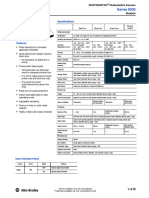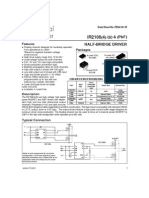Pa 11 U - User Manual Photoelectric Amplifier Series
Pa 11 U - User Manual Photoelectric Amplifier Series
Uploaded by
Sergio A. A.Copyright:
Available Formats
Pa 11 U - User Manual Photoelectric Amplifier Series
Pa 11 U - User Manual Photoelectric Amplifier Series
Uploaded by
Sergio A. A.Original Title
Copyright
Available Formats
Share this document
Did you find this document useful?
Is this content inappropriate?
Copyright:
Available Formats
Pa 11 U - User Manual Photoelectric Amplifier Series
Pa 11 U - User Manual Photoelectric Amplifier Series
Uploaded by
Sergio A. A.Copyright:
Available Formats
PA 11 U - USER MANUAL
Photoelectric Amplifier Series
1-channel manual photoelectric amplifier
EN tel
Product Data Output Mode Selection
The output mode can be selected via the light/dark switch. Refer to Output Logic table for
Electrical Data reference.
24 V ac, 115 V ac or 230 V ac
Supply voltage
24 V dc, supplied from Class 2 Source NOTICE!
For use as an entrapment protection device acc. to UL325 the operation mode MUST be
Voltage tolerance +/- 15%
Light Operated.
Power consumption Max. 3.5 VA
Output: relay 1 open / 1 closed, 250 V ac / 3 A, 120 V ac / 5 A
Enables the output to be
Output transistor 60 mA / 30 V dc
Light Operated inactive when there is an
object present.
Environmental Data
Enables the output to be
Temperature, operation -10 to +50 ºC
Dark Operated active when there is an
Sealing class IP 40 object present.
Approvals Output Logic
508 325
NOTICE!
Applicable Remote Sensors & Sensing Ranges
When used as an entrapment protection device acc. to UL325 and using relay output,
Remote Sensor Series 100 110 120 use terminals 1 and 3 (normally open contacts).
Sensing Range
Long range mode 12 m 26 m 46 m
Short range mode 4m 9m 15 m Relay Transistor Output
Detection (thru beam) Output mode
Output Output indicator
Object present
Illustration 1 3 4
Dark Closed On
PA 11 A xxxT PA 11 B xxxT
LT LR 1 3 4
Light Open Off
Object absent 1 3 4
Dark Open Off
LT LR 1 3 4
Light Closed On
Sensitivity Adjustment
Maximum sensitivity can be used for most applications and is advised for applications with
Connection contaminated environments e.g. dirt, water and dust. Increase the sensitivity to maximum by
turning the potentiometer to full clockwise position.
NOTICE!
Sensitivity adjustment may be required in applications where objects to be detected are small
For use as an entrapment protection device acc. to UL325:
or translucent. Proceed with the following steps:
Only for incorporation by a professional inside a Door, Drapery, Gate, Louver or Window
Operator or System after evaluation of the combination (assembly) has shown appliance
Adjust the sensitivity to maximum by turning the potentiometer to full clockwise
with the applicable standards. 1
position.
Wiring Diagrams Check there is no object present interrupting the beam and the sensor pair is
2
correctly aligned and within their specified sensing range.
3 Select target object with smallest dimensions and most translucent surface.
Place target object between remote transmitter and receiver sensors. If the output
4 status changes, adjustment is not required. If the output status has not changed
proceed to step 5.
Decrease the sensitivity by turning the potentiometer counter clockwise until the
5
output is activated.
PA 11 X 3UXT models
6 Remove target object. Observe the output status has changed.
If the signal level is low, the green LED (signal status) will go off. In general, it is
recommended to increase the sensitivity till the LED goes on and to check the
following:
Alignment of sensors
Transmitter and receiver sensors are within sensing range
Sensor heads are not excessively contaminated
Time Delay Adjustment
NOTICE!
PA 11 X 4UXT models For use as an entrapment protection device acc. to UL325 set both delays to 0 (counter
clockwise).
Connection Steps
1 Check the power supply and output of the amplifier type. The on delay enables output signal to only activate if an object in the detection area is present
for the adjusted time period. (In Dark operated mode)
2 Make sure power is off. Connect wires to the 11-pin socket according to wiring diagram.
The off delay enables output signal to remain activated for the adjusted time period.
3 Plug-in the amplifier into the 11-pin socket. Turn power on. The time delay is adjustable between 0 - 10 sec.
Increase or decrease on delay by turning potentiometer clockwise or
4 When the amplifier is operating, the green LED (power-on) is on. On delay
counter clockwise respectively.
The red LT and LR sensor failure LEDs indicate a sensor failure, which can be due to a Increase or decrease off delay by turning potentiometer clockwise or
5 shorted connection or a faulty sensor. Off delay
counter clockwise respectively.
Notice: When the test switch is off, the LT failure LED will be on
Test Input
To fulfil safety requirements to entrapment protection devices the protection system must be
Adjustments tested at each end of the opening or closing cycle.
The test is performed by the door operator system by activating the test Input (terminal 11), by
Long/Short Range Selection connecting it to “Load Supply -“. The transmitter will stop transmitting corresponding to an
Long range mode enables the system to operate at 100% (maximum range). interruption of the light beam. The door operator system shall ensure that the output is de-
energized. The door operator system shall then de-activate the test input, and ensure that the
Short range mode enables the system to operate at 30% of maximum range, in order to ease
output is energised again.
sensitivity adjustment at shorter ranges.
Long range Enable transmitter Open switch or NPN transistor, voltage above 3 V dc
Short range Disable transmitter Close switch or NPN transistor, voltage below 1 V dc
Website: www.telcosensors.com V 1.1 Part Number: 0666220655
E-Mail: info@telcosensors.com December 2010 edition
Made in Denmark Telco A/S reserves the right to make changes without prior notice
You might also like
- Electrical Installation Certificate - RedDocument7 pagesElectrical Installation Certificate - RedMark Cotten100% (3)
- Electrical Machines Ii Lab Indirect QuestionsDocument2 pagesElectrical Machines Ii Lab Indirect QuestionsThangaraj KNo ratings yet
- CPRI Type Test ReportsDocument2 pagesCPRI Type Test ReportsRajkumar S R0% (1)
- Pa 11 A/B - User Manual Photoelectric Amplifier SeriesDocument1 pagePa 11 A/B - User Manual Photoelectric Amplifier SeriesLouie DefensorNo ratings yet
- Input_output_unit_with_isolator_iss_7_lockedDocument3 pagesInput_output_unit_with_isolator_iss_7_lockedpatwh67No ratings yet
- Er2-22 ManualDocument5 pagesEr2-22 Manualjose uriel olvera chavezNo ratings yet
- LP 2951Document36 pagesLP 2951Wassim JamalNo ratings yet
- Data Sheet: Light Activated SwitchDocument2 pagesData Sheet: Light Activated SwitchZaw ZawNo ratings yet
- Datasheet Photo SwicthDocument3 pagesDatasheet Photo Swicthdwi aryantoNo ratings yet
- CG5151LA Rev1.04 Datasheet 151207Document11 pagesCG5151LA Rev1.04 Datasheet 151207qasimjamal123No ratings yet
- Automotive Direction Indicator: Technical DataDocument6 pagesAutomotive Direction Indicator: Technical Data_gekidoNo ratings yet
- LXDC2HL - Series DatasheetDocument32 pagesLXDC2HL - Series DatasheetAxel FoleyNo ratings yet
- Void Infinite 4 mk2 Infinite 6 mk2 Service ManualDocument17 pagesVoid Infinite 4 mk2 Infinite 6 mk2 Service ManualIRAWAN SURYANATANo ratings yet
- Switch Amplifier KHA6-SH-Ex1: FunctionDocument5 pagesSwitch Amplifier KHA6-SH-Ex1: FunctionandreNo ratings yet
- Chemetron Micro SLX Installation Wiring DiagramDocument1 pageChemetron Micro SLX Installation Wiring DiagramJuanNo ratings yet
- Telco sg10 Usermanual enDocument3 pagesTelco sg10 Usermanual enconny.wizardNo ratings yet
- Tsop 4038Document5 pagesTsop 4038chaurais59No ratings yet
- Output Module S-A4045Document2 pagesOutput Module S-A4045Ashiq SalmanNo ratings yet
- ALTO-MAC+2 4+Service+manual+V 2Document26 pagesALTO-MAC+2 4+Service+manual+V 2Marcos silvaNo ratings yet
- Photo Sensor KM787546G01Document2 pagesPhoto Sensor KM787546G01thanggimme.phanNo ratings yet
- MTL4501-SR - MTL5501-SR: Fail-Safe Switch/Proximity-Detector InterfaceDocument1 pageMTL4501-SR - MTL5501-SR: Fail-Safe Switch/Proximity-Detector InterfaceAndy Kong KingNo ratings yet
- RP3 Data SheetDocument2 pagesRP3 Data SheetEbrahim RahimiNo ratings yet
- El 357 NG ComDocument11 pagesEl 357 NG ComAnonymous oEoCVNhu7HNo ratings yet
- Datasheet PC13Document11 pagesDatasheet PC13Cuong TranNo ratings yet
- Apollo - Zone IsolatorDocument3 pagesApollo - Zone Isolatorac fkNo ratings yet
- SLO320 Specification Sheet F-28197-1Document3 pagesSLO320 Specification Sheet F-28197-1Heathen ChemistNo ratings yet
- Hitachi x200 Series Inverter Reference GuideDocument25 pagesHitachi x200 Series Inverter Reference GuideRycky de la CruzNo ratings yet
- Hitachi x200 Series Inverter Reference GuideDocument25 pagesHitachi x200 Series Inverter Reference GuideMochamad AldiNo ratings yet
- Features: DescriptioDocument17 pagesFeatures: DescriptioevilplayerindoNo ratings yet
- Anciènne Barrière MTL3043Document1 pageAnciènne Barrière MTL3043Yasmina BethyNo ratings yet
- Eaton 041097 P1 25 EA SVB en - GBDocument6 pagesEaton 041097 P1 25 EA SVB en - GBAnonymous jW9BkgbQmENo ratings yet
- Tda 8563Document20 pagesTda 8563dinnhowNo ratings yet
- Luggage Security ProjectDocument4 pagesLuggage Security ProjectTI NafisNo ratings yet
- Datasheet Tda8563Document16 pagesDatasheet Tda8563fabioboogNo ratings yet
- Littelfuse TVS Diode Array SP3304N Datasheet PDFDocument4 pagesLittelfuse TVS Diode Array SP3304N Datasheet PDFJoão AlmeidaNo ratings yet
- Manual Isl A-B Linear-ScaleDocument7 pagesManual Isl A-B Linear-Scaletrần thị dungNo ratings yet
- S1313 - E ReguladoDocument49 pagesS1313 - E Reguladocristal cristalNo ratings yet
- SPN240D Data SheetDocument1 pageSPN240D Data SheetQC JorgNo ratings yet
- MTL5012 PROXIMITY DETECTOR Interface BarrierDocument1 pageMTL5012 PROXIMITY DETECTOR Interface BarrierAhmed GhreebNo ratings yet
- Electricos MT IUSADocument5 pagesElectricos MT IUSALanh GonzáLezNo ratings yet
- Cr3-A 2 035 P: CR-series SCR Operation ManualDocument4 pagesCr3-A 2 035 P: CR-series SCR Operation ManualBENJAMIN COLELLNo ratings yet
- El1018 (TB) VGDocument12 pagesEl1018 (TB) VGRemy MendozaNo ratings yet
- Dettronics Flame Detetor MANUALDocument27 pagesDettronics Flame Detetor MANUALNanu PatelNo ratings yet
- Manual Autonics Pa10Document8 pagesManual Autonics Pa10yulfreNo ratings yet
- Fa-Bus ModuleDocument9 pagesFa-Bus ModuleFranklinNo ratings yet
- LP295x Adjustable Micropower Voltage Regulators With ShutdownDocument31 pagesLP295x Adjustable Micropower Voltage Regulators With ShutdownLuis Fernando Garcia SanchezNo ratings yet
- Semi Eng Gu1a Aqy21 KsDocument16 pagesSemi Eng Gu1a Aqy21 KsSean WilkinsNo ratings yet
- Zero Voltage Switch CA3059: ON SemiconductorDocument8 pagesZero Voltage Switch CA3059: ON SemiconductordangthanhlinhNo ratings yet
- Tda 8563 QDocument20 pagesTda 8563 QDiegoNo ratings yet
- Int 250Document7 pagesInt 250Jesin KimNo ratings yet
- Allen Bradley 42BA S2LNAC A2Document3 pagesAllen Bradley 42BA S2LNAC A2soayNo ratings yet
- Discontinued Product: Ultra-Sensitive Dual-Channel Quadrature Hall-Effect Bipolar SwitchDocument21 pagesDiscontinued Product: Ultra-Sensitive Dual-Channel Quadrature Hall-Effect Bipolar Switchpedro guerraNo ratings yet
- TLP3475S Datasheet en 20200225Document10 pagesTLP3475S Datasheet en 20200225sinan akbaşNo ratings yet
- Advanced Tracer: User's ManualDocument24 pagesAdvanced Tracer: User's ManualTECSOIN SRLNo ratings yet
- SCRDocument4 pagesSCRariefNo ratings yet
- It 7301 PC - Hardware UsermanualDocument12 pagesIt 7301 PC - Hardware UsermanualCuong PhungNo ratings yet
- 42mrr 5000Document9 pages42mrr 5000soayNo ratings yet
- Bosch Ic cj950Document4 pagesBosch Ic cj950dmitry esaulkovNo ratings yet
- En-Ee sx3340 4340-1101432Document7 pagesEn-Ee sx3340 4340-1101432Thành Tiến VănNo ratings yet
- BTS409L1 PDFDocument15 pagesBTS409L1 PDFFreezzbyNo ratings yet
- A501_A502_INT301_INT302_69000145_2Document1 pageA501_A502_INT301_INT302_69000145_2john.smith1917442No ratings yet
- Lab 3 - TECDocument11 pagesLab 3 - TECIonelNo ratings yet
- Integrated Analog/Digital Bicmos ProcessDocument8 pagesIntegrated Analog/Digital Bicmos ProcessJyothi PoornaNo ratings yet
- 8lsa24.r0060c019 0 Silnik Servo B&R Automation ManualDocument148 pages8lsa24.r0060c019 0 Silnik Servo B&R Automation ManualJose Luis Arellano CamachoNo ratings yet
- Solar Supercapacitor Applications by Phillip HurleyDocument20 pagesSolar Supercapacitor Applications by Phillip Hurleyleigh5185No ratings yet
- Lgp49dj-17u1 Eax67189201 Eay64511101Document4 pagesLgp49dj-17u1 Eax67189201 Eay64511101jamor100% (1)
- HONEYWELL - NPB-2X-RS485 Installation Instruction 95-7778 PDFDocument4 pagesHONEYWELL - NPB-2X-RS485 Installation Instruction 95-7778 PDFMarcello PorrinoNo ratings yet
- Cable RepairDocument96 pagesCable RepairHamish SchnurigerNo ratings yet
- TSB-1057 Universal Alternator WiringDocument3 pagesTSB-1057 Universal Alternator WiringKarim Moussa100% (2)
- VaristorsDocument56 pagesVaristorsvalentinlupascu33No ratings yet
- TCC Number 153 2Document1 pageTCC Number 153 2marianaofdNo ratings yet
- Comprehensive Viva ON Transfer Wave Tube (TWT)Document12 pagesComprehensive Viva ON Transfer Wave Tube (TWT)pavan reddyNo ratings yet
- Cod.380S.B: Instruction ManualDocument24 pagesCod.380S.B: Instruction Manualamskroud brahimNo ratings yet
- Ir 2108Document23 pagesIr 2108robertofurlancriNo ratings yet
- Generator Control Units and External Power 6.18 6.19Document10 pagesGenerator Control Units and External Power 6.18 6.19Ye MinNo ratings yet
- Technical Catalogue Type B6, B7Document22 pagesTechnical Catalogue Type B6, B7yonesNo ratings yet
- Why There Is No Igbt Traction RectifiersDocument9 pagesWhy There Is No Igbt Traction RectifiersLaurence MichaelNo ratings yet
- Banner - Introduction To MOSFETDocument1 pageBanner - Introduction To MOSFETAviral ChaurasiaNo ratings yet
- BELANKODocument24 pagesBELANKOshriramrnrNo ratings yet
- RD12MVS1: Silicon RF Power MOS FET (Document8 pagesRD12MVS1: Silicon RF Power MOS FET (RickyNSNo ratings yet
- V9 Series High-Performance AC DriveDocument213 pagesV9 Series High-Performance AC DriveGer FloresNo ratings yet
- 1.b. Fire Pump MotorDocument4 pages1.b. Fire Pump MotorNOMANNo ratings yet
- Power Factor CodeDocument9 pagesPower Factor CodeKen AndradeNo ratings yet
- FinalhvlabDocument54 pagesFinalhvlabSuman PatraNo ratings yet
- Addc Procedures For 22kv Permananet Power SupplyDocument8 pagesAddc Procedures For 22kv Permananet Power Supplybasem_eng77No ratings yet
- Engineering Utilities Module 4Document134 pagesEngineering Utilities Module 4Neerom BaldemoroNo ratings yet
- Tpic 6 C 596Document12 pagesTpic 6 C 596Dedi SetyanaNo ratings yet
- A SAFEhouse Guide To SocketsDocument2 pagesA SAFEhouse Guide To SocketsPercy GoitsemangNo ratings yet
- Datasheet Ksd471-Y NPN SiliconDocument3 pagesDatasheet Ksd471-Y NPN Siliconkikirikiw802No ratings yet

























































































